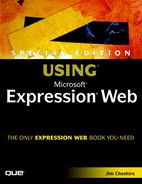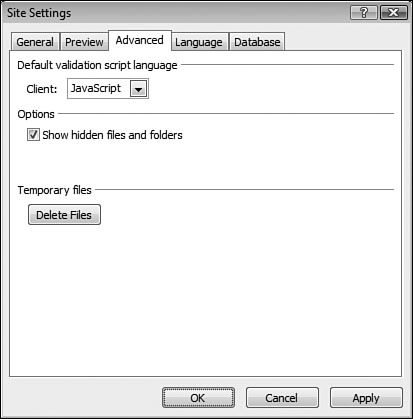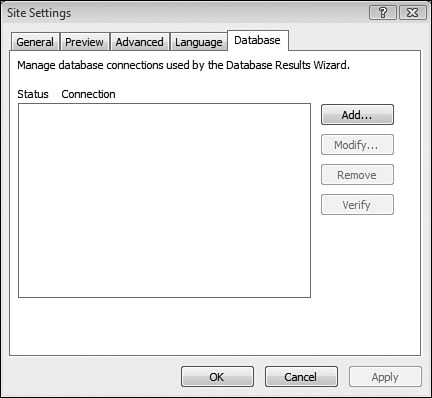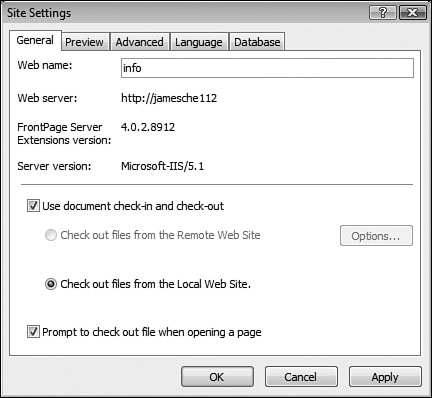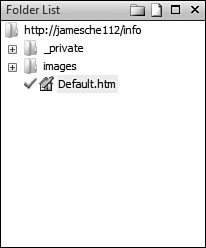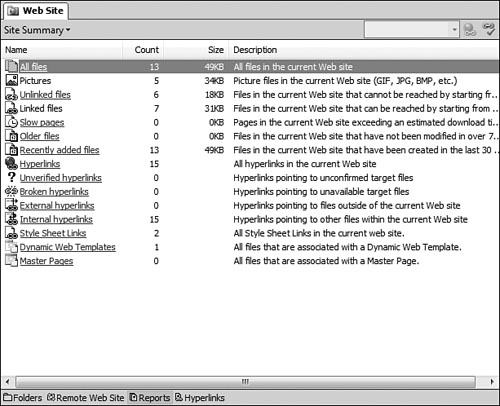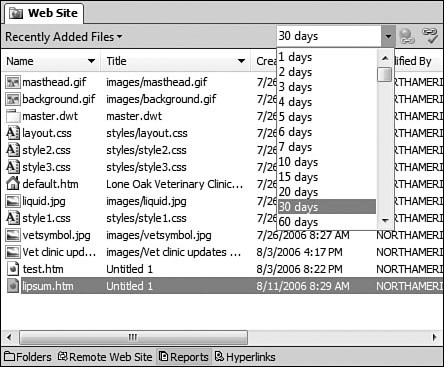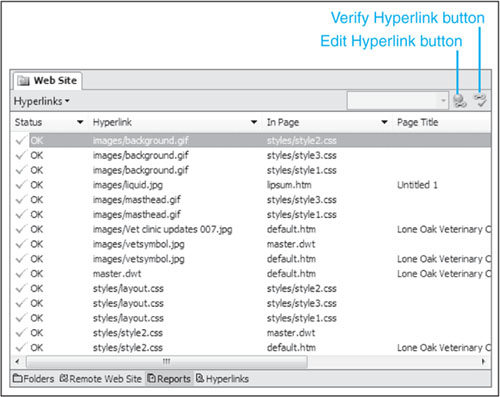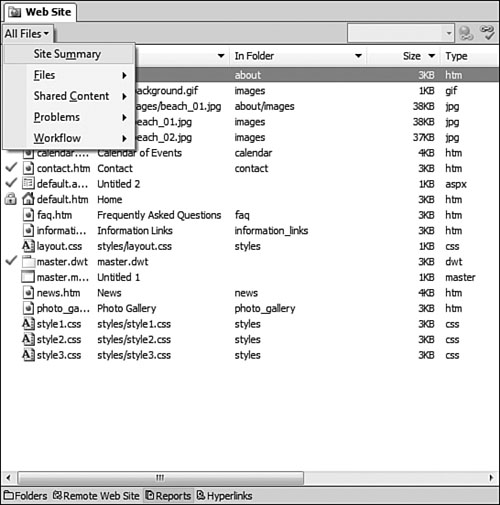While Expression Web can certainly be used to create and edit single Web pages, it really shines when used for creating and managing entire Web sites. This is one of the features that Expression Web has carried over from its predecessor, FrontPage.
Several configuration settings in Expression Web are designed to affect an entire Web site. These settings are available in the Site Settings dialog shown in Figure 4.1.
Tip
If you have a remote Web site open in Expression Web, you may experience a delay of several seconds before the Site Settings dialog appears. The FrontPage Server Extensions have to read the site’s entire configuration before the dialog is displayed.
This delay is not experienced with disk-based Web sites.
To access the Site Settings dialog, select Site, Site Settings. There are five tabs in the Site Settings dialog.
The General tab displays general information about the Web site and allows you to change the name of the Web site, configure the use of metadata, and configure source control settings.
When you change a Web site’s name in the General tab, the folder name changes as well. If the Web site is server-based, the URL for the Web site will change too.
We’ll cover source control later in this chapter.
The Preview tab configures how Web pages should be previewed, as shown in Figure 4.2. You can choose to preview using a Web site’s path (including using the ASP.NET Development Server for ASP.NET pages) or a custom URL.
→ | For more information on using and configuring the ASP.NET Development Server, see “Using the ASP.NET Development Server,” p. 485 (Chapter 27). |
Using a custom URL is convenient when you need to use a different URL for previewing than the URL used to open the site in Expression Web. For example, if you are using a disk path in Expression Web for a Web site located on a Web server, you can enter an HTTP path for the custom URL that maps to the disk location used by Expression Web. When pages are previewed in Expression Web, they will be opened using the URL you specify.
The Advanced tab (shown in Figure 4.3) configures the language used for form field validation, determines whether or not hidden files and folders will be visible, and allows for the deletion of temporary files.
→ | For more information on form field validation, see “Using Form Controls,” p. 195 (Chapter 11). |
By default, hidden files and folders are not visible in the Folder List and other Expression Web views. (This also includes meta information in _vti folders.) If you’d like to be able to see these hidden files and folders, check the Show Hidden Files and Folders checkbox and click OK. When you do, Expression Web will ask if you want to refresh the Web site. Click Yes and you will see hidden files and folders appear in Expression Web.
The Delete Files button will delete temporary files that are created for Expression Web to keep track of your Web site. While these files don’t take up much room on your hard drive, they can become corrupted and cause strange behavior. Deleting them periodically is a good idea for this reason.
Tip
One of the symptoms of corrupt temporary files is a Web site that won’t open. Many times, this kind of problem results in constant disk activity until the Windows swap file fills up and you run out of disk space.
If you run into a problem like this and can’t open a site to delete temporary files, you can manually delete the files. They are located in C:Users<user>AppDataRoamingMicrosoftWeb Server ExtensionsCache on Windows Vista and Documents and Settings<user>Application DataMicrosoftWeb Server ExtensionsCache on Windows XP. Make sure that Expression Web is closed and then delete all files with a .web file extension.
The Language tab (shown in Figure 4.4) configures the language used for server messages and defines the encoding used for Web pages.
The setting in the Server Message Language dropdown applies only to FrontPage Server Extensions messages. If the Web site opened in Expression Web is not a FrontPage Server Extensions-based Web site, the Server Message Language dropdown will contain only English as an option.
Note

If you make a change to page encoding and it’s not reflected in your pages, see “Page Encoding Doesn’t Affect Pages” in the “Troubleshooting” section of this chapter.
The Default Page Encoding dropdown configures the character set specified in the content-type META tag added to Web pages. The browser uses page encoding to determine which character set to use. When the character set is incorrect, the page does not display correctly.
Expression Web uses a default setting of utf-8 (Unicode), which supports all languages and is the correct encoding for XHTML documents.
→ | For more information on XHTML, see “Compatibility Features in Expression Web,” p. 339 (Chapter 19). |
The Database tab (shown in Figure 4.5) configures database connections for use with legacy ASP pages. When you configure a database connection on the Database tab, Expression Web will add the connection to a global.asa file in the root of the Web site.
Both the global.asa file and the database connections Expression Web store in it are used only with ASP and do not apply to ASP.NET or other server technologies. For this reason, it’s recommended that you not use this tab for your database connections.
Tip
The Database tab is actually a left-over feature from FrontPage. While Expression Web does not allow you to insert Database Results components that were available in FrontPage, it will allow you to modify existing Database Results components that were previously inserted in FrontPage. For that reason, the Database tab remains in Expression Web.
When you are working with a group of designers, it can be cumbersome to ensure that two people don’t edit the same file at the same time. To combat this problem, Expression Web offers a rudimentary source control system.
A source control system implements a document checkout system for a Web site. When you open a file, you are asked if you would like to check it out. If you choose Yes, the file is opened and checked out to you. Until you either check the file back in or undo your checkout, the file will be flagged as being checked out to you.
There are two types of source control systems supported by Expression Web: Expression Web’s own source control system and Visual SourceSafe integrated source control.
Expression Web’s source control is configured by selecting Site, Site Settings and then clicking the General tab. As shown in Figure 4.6, checking the Use Document Check-in and Check-out checkbox enables source control for a Web site.
Note

If the source control options in the Site Settings dialog are disabled, see “Source Control Options Disabled” in the “Troubleshooting” section of this chapter.
After you’ve enabled source control, when you open a file, you will be prompted to check the file out prior to opening it. If you select Yes to check the file out, the file will be opened and a check will appear next to the file in Expression Web, as shown in Figure 4.7.
Tip
You can also check out a file by selecting the file and then selecting Edit, Check Out or by pressing Ctrl-J.
After you’ve checked a file out and made the necessary edits to it, you can either check the file back in or undo the checkout. If you undo the checkout, any changes you made will be discarded.
To check a file in, right-click the file in the Folder List and select Check In. Alternatively, you can select the file and then select Edit, Check In or press Ctrl-Shift-J. To undo a checkout, right-click the file in the Folder List and select Undo Check Out. Alternatively, you can select the file and then select Edit, Undo Check Out.
When a file is checked out by someone else and you attempt to open it, you will be asked to create a read-only copy of the file. Any changes you make to that file cannot be saved until the file is checked back in.
Caution
If you open a read-only copy of a file checked out by someone else, make a change, and then save that file after the original user has checked the file back in, it is possible to overwrite changes that the original user made to the file. Therefore, it is always best to not make any edits to a file until you have successfully checked it out.
Caution
If you open a read-only copy of a file inside of an editor other than Expression Web and the file is checked out by someone else, it is possible to save changes to the file even though the file is already checked out by someone else.
If you are using an editor other than Expression Web for editing files under source control, it’s best to not open files for editing unless you check them out yourself.
Expression Web supports the use of Visual SourceSafe integrated source control via the FrontPage Server Extensions. Visual SourceSafe is a source control system from Microsoft that offers considerably more features than Expression Web’s own source control system.
Visual SourceSafe integrated source control must be configured on the Web server itself, and many find it to be a problematic process. It’s best to leave it to server administrators, even if you have access to the Web server yourself.
→ | For more information on Microsoft Visual SourceSafe, see msdn.microsoft.com/vstudio/previous/ssafe/. |
When working on a large Web site, it’s a good idea to implement a workflow system whereby documents are distributed for review to particular individuals. During this process, it often helps to categorize documents so the workflow can be more clearly defined. Expression Web provides features that support taking these steps.
As shown in Figure 4.8, the Workgroup tab of the Page Properties dialog provides features to aid in workflow. To access this dialog, select the desired file or files and then select File, Properties.
Tip
The Page Properties dialog box where the Workgroup tab is located has a different appearance and different options based upon whether or not the file whose properties you are examining is open in Expression Web. However, the options on the Workgroup tab are identical in either case.
By clicking the Categories, Names, and Statuses buttons, you can edit the list of categories, add or remove names for reviewers, and edit the list of review statuses. Using these methods, you can customize the workflow settings for your own specific needs.
When a page is assigned to someone for review, it’s likely that you won’t want to publish that page to the live Web site when the site is published. To prevent the file from being published with the rest of the site, check the Exclude This File When Publishing the Rest of the Web checkbox. Alternatively, you can right-click the file and select Don’t Publish.
Note

If the settings in the Workgroup tab don’t show correct data, see “Workgroup Settings Aren’t Correct” in the “Troubleshooting” section of this chapter.
One of Expression Web’s greatest strengths is in the area of site management. The large array of reports available makes managing a site easier by providing indicators of problems and giving details on other aspects of your Web site.
The Site Summary view provides a link to some of the reports in Expression Web and also summarizes information about the site. To view the Site Summary (shown in Figure 4.9), select Site, Reports, Site Summary.
To access all the reports in Expression Web, select Site, Reports and choose the desired report. The following reports are available in Expression Web:
All Files—. Displays all files in the Web site in a single view. This report also shows the title, location, and other properties of each file.
Recently Added Files—. Displays all files recently added to the Web site. As shown in Figure 4.10, you can select a specific number of days to display files added within that number of days.
Recently Changed Files—. Displays all files that have recently changed. Just as with the Recently Added Files report, you can select a specific number of days to display files that have changed within that number of days.
Older Files—. Displays all files older than 72 days by default. The number of days can be adjusted using the Report Setting dropdown.
Checkout Status—. Displays the checkout status of files and shows who (if anyone) has each file checked out.
Dynamic Web Templates—. Shows all Dynamic Web Templates and their file connections.
→
For more information on Dynamic Web Templates, see “Using Dynamic Web Templates,” p. 363 (Chapter 21).
Master Pages—. Displays all files and any master pages used by each file.
→
For more information on Master Pages, see “Using ASP.NET Navigation Controls,” p. 527 (Chapter 29).
Style Sheet Links—. Displays all pages and any style sheets linked to them.
→
For more information on using style sheet links, see “Managing CSS Styles,” p. 311 (Chapter 18).
Unlinked Files—. Shows all files that are not linked to by links that can be followed from the home page.
Slow Pages—. Displays all pages that will take longer than 30 seconds to load by default. The time threshold can be adjusted using the Report Setting dropdown.
Hyperlinks—. Displays the status of each hyperlink. Hyperlinks can be checked or edited using the Verify Hyperlink or Edit Hyperlink button, respectively, as shown in Figure 4.11.
Review Status—. Shows the review status for each file in the site. This report also shows to whom each file is assigned.
Assigned To—. Similar to the Review Status report, this report shows to whom each file is assigned for review.
Categories—. Displays each page and the category (if applicable) to which it is assigned.
Publish Status—. Displays the publish status of each file in the Web site. If a file is configured to not publish with the rest of the site, it will be labeled as Don’t Publish in this report.
Using these comprehensive reports, you can maintain tight control over the files in your Web site.
The reports in Expression Web are generated using some preset defaults. For example, the download speed of a page assumes a 56k connection by default and the Recent Files report lists files that are fewer than 30 days old by default. You can configure these defaults by selecting Tools, Application Options to access the Application Options dialog shown in Figure 4.12.
After viewing a specific report, you can return to the Site Summary view by clicking the name of the current report in the upper-left corner of the main window and selecting Site Summary as shown in Figure 4.13.
I have set the page encoding to something other than the default, but it doesn’t seem to affect the content-type META tag in my pages.
The page encoding setting only affects new pages that are created in Expression Web. It will not affect existing pages.
I’d like to enable document checkin and checkout, but the options to do so are disabled and I can’t select them.
It’s likely that you are using a server-based Web that is on a Web server running the FrontPage Server Extensions. If the FrontPage Server Extensions are configured to use an external source control system, the source control options in Expression Web will not be available.
Check with your host or server administrator.
I know that I have assigned a few files to a specific person for review, but when I look at the properties for the files, it doesn’t show that they are assigned to anyone.
Expression Web uses metadata to keep track of review assignments. The best way to correct bad metadata is to recalculate hyperlinks on the Web site. Select Site, Recalculate Hyperlinks to recalculate hyperlinks.
Building a Web site is a complex project. One of the greatest challenges in initiating a Web site project is getting everyone coordinated and assigning responsibilities. Expression Web can help you do that if you make the most of the features it provides.
The first thing you should do is set up categories for reviewers. You can use names of departments, sections of the site, or anything else that allows for a logical categorization of your pages. You’ll then want to add all your reviewers to Expression Web. Both of these tasks are accomplished using the Page Properties dialog shown previously in Figure 4.8.
Once you’ve gotten all your categories and names set up, assign each page to someone for development. As the team progresses through the development and review processes, update the review status appropriately. Using this method, you’ll always be able to find out where you are in the project by using the Review Status report in Expression Web.
Like any other feature, the workflow features of Expression Web are only beneficial if you configure them to work for you. Don’t dismiss these features simply because the way they are configured out of the box don’t fit your style of working. Modify the configuration so it suits you and the way your project is designed and you’ll be more efficient.
